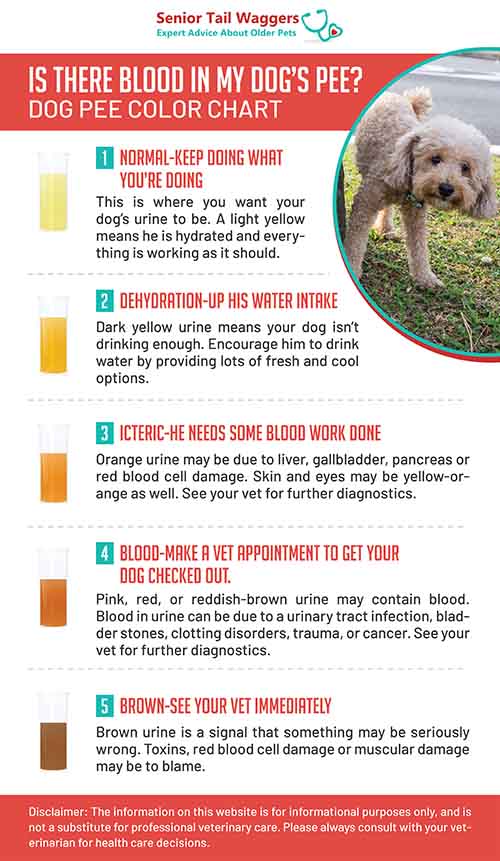
The dog pees with blood: why this happens, the reasons and advice on what to do in this situation
Discuss the topic on our forum.
When dogs have blood in their urine, the color of the urine changes from light pink to coffee and cherry. Do not forget that even the slightest change in the urine in most cases indicates that she is sick with something. It very rarely happens that due to any products or preparations, the color of the urine changes due to the presence of coloring pigments. Blood is not always visible during a dog’s bowel movement, there are times when blood is detected only after a laboratory test. The appearance of blood in the urine of a dog in most cases indicates that the process of inflammation of the urinary system is taking place in the body.
Contents
Reasons why a pet pees blood
As soon as the owner notices a deviation in the color of urine in a dog, it is necessary to immediately exclude the following: possible reasons:
- any internal injury
- the presence of neoplasms in a dog, for example, venereal sarcoma
- the presence of stones in the kidneys, urinary tract or bladder
- prostate disease in male dogs
- other diseases of the reproductive system
- poisoning can also lead to discoloration in the urine, including poisoning with rat poison
- a number of parasitic and infectious diseases
- blood may be present in the urine due to the presence of a disease that is associated with poor blood clotting, which leads to the destruction of blood cells (erythrocytes)
By the amount and when blood appears in the dog’s urine, one can assume the cause of what is happening, however, the diagnosis should be made by the veterinarian after a thorough examination and all necessary research.
When males develop disease of the prostate, and females of the vagina and uterus, blood can appear both in the urine and during periods when there is no urination. In these cases, the blood is clearly visible and appears at the beginning of urination.
If the disease involves the bladder or urination canal, blood will also be clearly visible, especially if a tumor is present or simply severe inflammation. Often with such diseases, the process of urination changes: dogs begin to urinate more often, pain during urination or incontinence appear. At the same time, the condition and behavior of the dog may not change, this applies to activity and appetite.
If the disease has affected the ureters or kidneys, then the blood is most often determined only with the help of laboratory tests, however, there may be exceptions. Urination may not change in any way, however, the daily amount of urine may change. The animal becomes lethargic, the dog loss of appetite, there may be a strong thirst and more. If there is a suspicion that the dog has problems with the urinary system, it is necessary to constantly monitor whether the dog goes to pee at all.
If the dog does not go to the toilet for more than twelve hours, you should immediately consult a doctor. The same actions must be done if blood was seen in the urine, so that the doctor examines the dog and prescribed appropriate treatment. If the dog feels well and does not experience problems with urination, then the situation is not an emergency.
Even if the urine is significantly stained with blood, in most cases this does not lead to large blood loss. It is not recommended to give without consulting a doctor, any drugs that stop the bleeding.
If the urine has not changed significantly, but the dog has difficulty urinating, there is less urine, vomiting and lethargy have appeared, and the pet refuses to eat to the doctor must be contacted immediately.
It is not worth self-medicating a dog, because blood in the urine can appear for many reasons, if you do not establish an accurate diagnosis, self-medication can be dangerous. Virtually all animal clinics offer home visits, but in addition to urinalysis and routine examinations, other tests, such as x-rays or ultrasounds, are often needed. These procedures are done in the clinic itself, so it is recommended immediately take the dog to a specialized institution and on site to make all the necessary procedures and checks.
Information to be provided to the doctor
The dog must be observed very carefully so that, if necessary, provide the veterinarian with the following information:
- what was the color of the urine in the last few days
- whether there is pain during urination, how often the dog pees, in what position and what pressure of the jet
- can the animal control its urination
- whether blood is constantly present in the urine or occasionally
- what time do symptoms appear
- Is there spotting between urination?
- if the disease is not new, then it is necessary to tell what the previous treatment was and what results it gave
If additional studies are needed in the form of X-rays or ultrasound, the pet must have a full bladder, so it is not recommended to walk the dog before going to the doctor. These tests can answer the question why a dog pees blood.
Collecting urine from a dog: how it happens
Often, urine collection occurs naturally, a medium portion is desirable, that is, one or two seconds after urination begins. It is recommended to do a treatment before collecting urine: external genitalia rinsed with warm water or an antiseptic solution, for example, Chlorhexidine. If it was not possible to take urine in the usual way, the doctor takes a urine test using a catheter, the procedure does not bring pain to the pet and does not require any preparation.
There are times when more accurate diagnosis needed, for this, urine can be taken by puncturing the bladder. Often this is required if it is necessary to take urine for culture, this procedure can only be done by a doctor. All studies are aimed at finding out the cause of blood in the urine of a dog.





